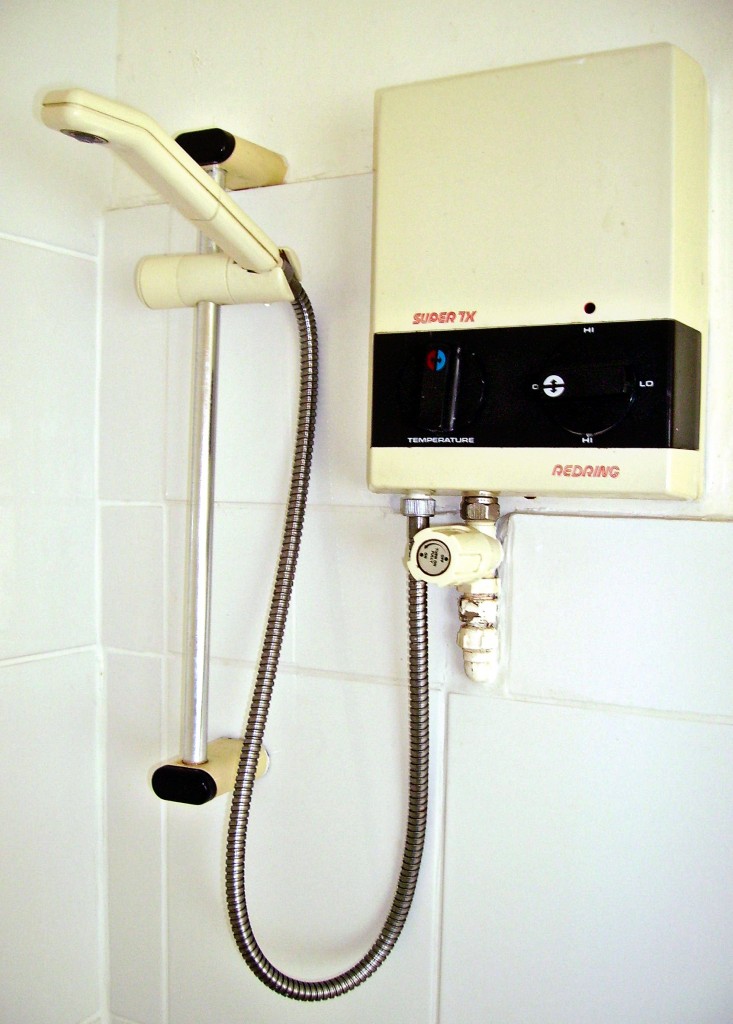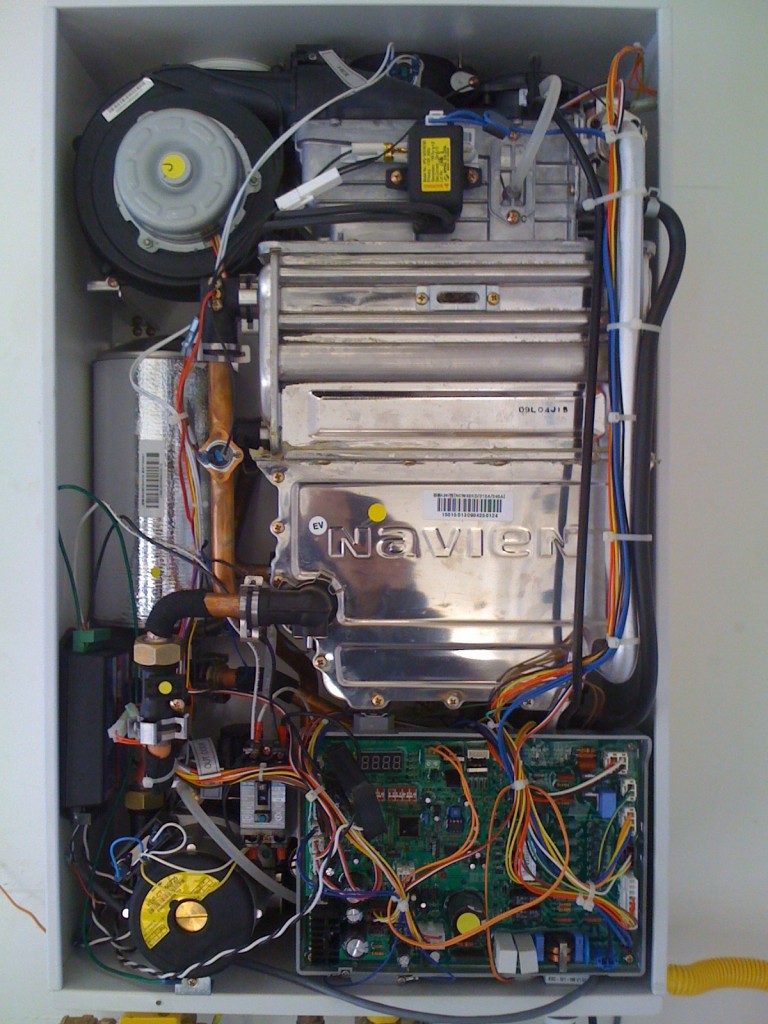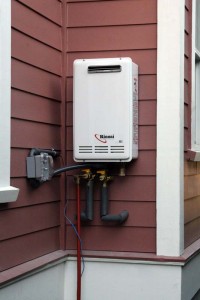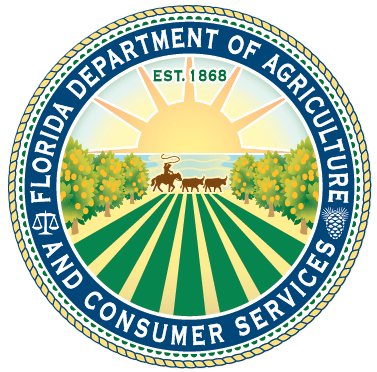Quick Facts
Tankless water heaters…
- Offer continuous flow hot water on demand within the flow rate constraints of the manufacturer make and model and the temperature rise considerations associated with your geographic area and your household needs.
- Have been found to perform 24 percent to 34 percent more energy efficiently than storage tank water heaters with further efficiency improvements possible as the technology continues to advance in the future.
- May offer more benefits in their convenience and longevity, than in their potential dollar savings, when calculated across their complete lifecycle costs for installation, operation, and maintenance.
- Are designed to last for 20+ years with modular designs that may offer easier servicing and replacement of parts versus storage tank water heaters.
- Typically require annual lime and scale removal maintenance in Florida due to our water quality.
- Can be installed indoors or outdoors depending on the location opportunities provided by your home’s plumbing and natural gas piping system designs.
Terms to Help Get You Started
- Isolation Valve Kit: Special valves installed at the cold water inlet and hot water outlet plumbing pipes that allow the water heater to be isolated from the incoming potable water supply for servicing
- Lime and Scale Flush: Routine maintenance service activity required once every 6 to 12 months to reduce the hard water deposits and scale
- Peak Gallons Per Minute (GPM): Maximum flow rate of a tankless water heater (reported as water volume per unit of time) that can be used by household plumbing fixtures simultaneously (e.g., each faucet may be 1.5 GPM and each shower may be 2.5 GPM, so two faucets and two showers running hot water all at once would have a peak flow rate of 8.0 GPM)
- Rise: Temperature differential between the coldest incoming potable water supply and the desired set point for the outgoing domestic hot water supply for use within a home
Introduction
There are many good water heating system technologies available in the marketplace today. This fact sheet is written to provide a more thorough review of whole-house tankless water heaters, particularly natural gas or liquid propane gas, hereafter simply referred to as “gas” throughout this publication. To better understand additional options in water heating system technologies available to consumers, see the following resources:
- U.S. Department of Energy. Energy Saver: Water Heating.
- Colon, C. and Parker, D. March 2013. Side-by-Side Testing of Water Heating Systems: Results from the 2010 – 2011 Evaluation. U.S. Department of Energy, Energy Efficiency and Renewalbe Energy, Building America Partnership for Improved Residential Construction (BA-PIRC).
Tankless water heaters, sometimes called “on-demand,” “instantaneous,” and/or “continuous flow” water heaters, work just as their name suggests: they heat water as needed, instead of storing previously-heated water in a tank. When the hot water tap is turned on, cold water travels through a pipe into the heating components. A gas-fired burner or an electric element heats the water, which is delivered to the hot water tap. As long as the tap is open, the hot water will flow…at least within the designed flow rate limits of the particular manufacturer make and model.
A note on tankless water heating system types and terminology
Low capacity, point-of-use tankless water heaters (Figure 1) are typically electrically heated with under 3 GPM flow rates and are designed to serve only one plumbing fixture or appliance. This fact sheet is about high capacity, whole-house tankless gas water heaters with higher GPM flow rates capable of serving multiple fixtures simultaneously. Whenever the word “tankless” is used in this fact sheet, it refers to whole-house tankless gas water heaters.

Figure 1. A point of use tankless water heater installed next to a shower. Credit: Immanuel Giel, Wikimedia.
Advantages
“Instantaneous” and “Limitless” Hot Water
One of the most important benefits of tankless designs is their use of energy only to heat water as needed, rather than keeping a 30-gallon to 50-gallon reservoir of water hot 24 hours a day. This instantaneous, hot water on demand can be supplied continuously without limit so long as the energy supplied to heat the water is continuous. Of course in reality, both the instantaneous and limitless concepts are somewhat inadequate (see the disadvantages section).
User Controls to Improve Comfort and Energy Savings
Many tankless water heater manufacturers offer accessory wired control modules that allow user temperature control and related functions (Figure 2). With these controllers, users can quickly adjust the hot water outlet temperature set point to minimize the water heating temperature rise from the cold water inlet. For example, in Florida, groundwater temperatures are typically between 72-77 degrees Fahrenheit (F), so setting the tankless unit to only heat the water to 100 degrees or 105 degrees Fahrenheit (versus 120 degrees Fahrenheit or more) can save both water heating time and energy as a result of a reduced water rise requirement.
![Figure 2. A whole-house tankless gas water heater installed in a laundry room with proper venting to the outdoors and a wired temperature and function controller on the wall to the right of the tankless unit. [Click image for full size version.] Credit: <a href="http://images.nrel.gov/viewphoto.php?imageId=6310913" target="_blank">Amy Glickson - Pixl Studio, Courtesy NREL</a>.](https://www.myfloridahomeenergy.com/wp-content/uploads/2015/06/14167-cropped-533x1024.jpg)
Figure 2. A whole-house tankless gas water heater installed in a laundry room with proper venting to the outdoors and a wired temperature and function controller on the wall to the right of the tankless unit. [Click image for full size version.] Credit: Amy Glickson – Pixl Studio, Courtesy NREL.
Longevity, Durability, and Lower Failure Risks
Another advantage to tankless water heaters is that their modular design (Figure 3) may offer more durability with improved servicing and parts replacement versus storage tank water heaters. Tankless water heating technology has been in use for several decades, especially in Europe and Asia. Evidence suggests they can last 20-years (sometimes even longer with replaceable components), as compared to the shorter 10-year to 15-year lifespan of a storage tank water heater. Additionally, while old or improperly maintained storage tank water heaters carry a risk of bursting and flooding the home, tankless water heaters (especially those installed outside) are likely to carry a lower flooding risk from system failure.

Figure 3. The modular components of a tankless water heater allow for increased accessibility to internal system parts for system servicing and parts replacement. Credit: Lieko Earle, NREL.
Compact Form Factor with Indoor or Outdoor Installation Flexibility
Whole-house tankless water heaters vary in size, capacity, and water flow rates depending on your household needs and the required temperature rise above your incoming local potable cold water supply. Generally, tankless water heaters are much more compact than storage tank water heaters with dimensions about one foot wide by two feet high by one foot deep and weighing 35 pounds to 80 pounds. Most manufacturers offer both interior (Figure 2) and exterior (Figure 4) mountable models. However, their specifications and installation requirements may vary by their location. When using interior mounted gas-fired models, direct venting to the outdoors is required.

Figure 4. A whole-house tankless natural gas water heater installed outdoors showing its more simple venting system. Credit: Flickr user “omiksemaj” (CC BY-NC 2.0).
In wide use in Europe and other parts of the world, tankless water heaters are still a relatively small, but growing, segment of the U.S. water heating market. The U.S. government’s Energy Information Administration reports that as of 2005—the last date for which there are figures—there were 1.1 million tankless water heaters (versus 96.6 million storage tank water heaters) in residential use across the United States. However, the numbers are rising as many homeowners are finding the energy-conserving idea of “heat it as you need it” appealing, to say nothing of the end to running out of hot water.
Disadvantages
Not Truly “Instantaneous” Hot Water
The words “instantaneous” and “unlimited” are often used in promoting tankless water heaters. However, it’s easy to misunderstand what manufacturers mean when they use them. While the water does begin heating “instantaneously” on demand, it still takes time for it to fully heat up to the user-defined temperature set point (i.e., to cover its full rise) and travel through your home’s piping to reach your shower or faucet—just as it does with a storage tank water heater.
Another common phenomenon for tankless users is the “cold water sandwich”—even if there’s hot water still in the line between the heater and the fixture, you may receive a momentary flush of cold water between the “old” and “new” hot water. This results from intermittent activation of the water heating elements due to repeated opening and closing of a hot water fixture or due to low and variable flow rates. However, some newer models are designed to eliminate the “cold water sandwich,” thus overcoming this common comfort deficiency of tankless water heaters. [1]
Not Truly “Unlimited” Hot Water
And while tankless water heaters do offer “unlimited”—that is, continuous—hot water, the flow rate of that unlimited hot water is based on the capacity of your particular plumbing system as well as the capacity of the manufacturer make and model. These are usually sized for your household’s typical peak water use. For example, two showers operating at the same time, or one shower and three faucets running simultaneously, rather than the unlikely scenario where all the faucets, all the showers, the dishwasher, and the washing machine are in use at once. In other words, if you estimate that it may be common to run one shower (at 2.5 GPM) and two faucets (at 1.5 GPM each) simultaneously, then you’d want a tankless water heater with a flow rate of at least 5.5 GPM. The calculator referenced later in this fact sheet can assist you with sizing your tankless water heater.
Minimum Flow Rates Required to Activate the Water Heating Process
Also note that a tankless water heater needs a minimum flow rate to operate, in most cases 0.5 GPM or greater. Below this rate, the heater’s burner may not ignite, so you could be out of luck if you try to get just a trickle of hot water for shaving. Lastly, unlike the water reservoir in storage tank water heaters, tankless designs provide no hot water during power outages (and that often includes gas-fired systems, which typically need electricity for ignition and venting).
Water Quality Affects System Performance and Durability
While not precisely a disadvantage, keep in mind that water quality may affect the operation of a tankless water heater. Virtually all of the tankless water heater manufacturers have disclaimers precluding warranty coverage of failures related to lime and scale accumulation from hard water deposits.
If you live in an area with hard water, the manufacturer may have specific recommendations for keeping your tankless water heater operating efficiently. Depending on how comfortable you are with “do-it-yourself (DIY)” work, you—or a professional—will need to perform maintenance tasks as required by the manufacturer to maintain your warranty. Later in this fact sheet, we provide some additional lime and scale flushing guidance for those DIY-inclined tankless water heater owners.
How Much Can You Save?
Energy Savings are Real and Measurable
Tankless gas water heaters are more energy-efficient than most comparable gas storage tank water heaters. In a study by the Florida Solar Energy Center (FESC) conducted from February 2009 through March 2010, a tankless gas water heater (29.2 cubic feet per day) saved 25 percent over the average energy consumption relative to a standard natural gas storage tank water heater (39.1 cubic feet per day). A follow up FESC study from September 2010 through August 2011 found similar savings of about 24 percent. The U.S. Department of Energy says “For homes that use 41 gallons or less of hot water daily, on-demand water heaters can be 24 percent to 34 percent more energy efficient than storage tank water heaters. They can be 8 percent to 14 percent more energy efficient for homes that use a lot of hot water—around 86 gallons per day.” The heat pump water heater (HPWH) included in the more recent FSEC study was the most efficient of the electric water heating systems with an average energy consumption of only 2.75 kWh per day, or 64 percent less than a standard electric 50-gallon storage tank water heater (see page 11). For households without natural gas or propane service, or for those who desire using electrical energy for water heating, HPWH models offer a very efficient option.
Dollar Savings Are Context Specific and May Be Modest
However, these real energy savings may not translate into dollar savings when accounting for a tankless water heater’s complete installation, operation, and maintenance costs. Installing a tankless water heater can be expensive, and may involve upgrading utilities, such as natural gas or electric service. This means there will likely be a longer payback period than for a regular storage tank water heater. And as discussed in the disadvantages above, flow rate limitations mean you’ll have to evaluate your family’s water use patterns in order to determine the tankless water heater capacity you’ll need. (How to calculate your energy and cost savings is discussed in a later section.) Keep in mind that the amount of energy and money you can save by converting to a tankless water heater varies according to your home’s unique circumstances, including the following:
- Your home’s water heating energy source
- Your home’s water heating temperature “rise”
- Your personal preferences for hot water temperatures “at the faucet”
- How much water your household typically uses, with instantaneous peak flow rates being more important to tankless water heater sizing than total water consumption over time
Efficiency Varies by Heat Source
While there are electric, propane, and natural gas whole-house tankless water heaters on the market, most experts recommend against purchasing an electric model because it generally does not deliver hot water quickly enough for most users. Additionally, electric models often require upgrading your home’s electrical service and, when operating, can draw as much power by itself as your entire home. If every home in the neighborhood had an electrical tankless water heater, the high instantaneous power draw during times of common use, such as morning showers, could combine to raise the local electric utility peak loads. Additionally, using natural gas as a direct, on-site heat source—rather than burning fossil fuels at the power plant to generate electricity, which is then used on-site to generate heat—reduces the impact on climate change and energy conversion losses.
However, watch out for models with a constantly burning pilot light—this can gobble up some of the energy you’re hoping to save by switching from a storage tank water heater. Check with the manufacturer regarding how much gas is consumed by the pilot light in the model(s) you’re considering. This can vary from model to model, so be sure to factor the fuel cost into your buying decision. Better yet, look at models with an intermittent ignition device (IID), which lights the gas heating elements only as needed.
Performance Varies According to Water Temperature Rise
The colder the water is when it enters your house, the more it’ll have to be heated for use. This temperature difference is called the rise. Experts recommend domestic hot water temperatures of 100 degrees to 120 degrees Fahrenheit, depending on system design, your personal preferences and water temperature comfort levels. The Centers for Disease Control and Prevention states, “Water heater thermostats should be set at about 120 degrees Fahrenheit (49 degrees Celsius) for safety and to save 18 percent of the energy used at 140 degrees Fahrenheit (60 degrees Celsius). Anti-scald devices for faucets and showerheads to regulate water temperature can help prevent burns.”
The building code requires the use of protective anti-scald valves at point-of-use fixtures when hot water supplies exceed 120 degrees Fahrenheit. In Florida, thanks to our warm climate, the incoming temperature averages about 72 degrees to 77 degrees Fahrenheit; so the rise is only 30 degrees to 50 degrees Fahrenheit, depending on the time of year, location within the state and how hot you like your morning shower. This compares to the 60 degrees to 70 degrees Fahrenheit rise needed by a home in one of the northern states due to colder air temperature and water supply temperatures.
With a lower rise, a tankless water heater can raise the temperature, faster, and with a higher gallon per minute (GPM) output. A model that produces 9.8 GPM when installed in Florida will produce only 5.6 GPM in Vermont because the colder water there requires the temperature to be raised 58 degrees Fahrenheit, rather than 28 degrees Fahrenheit. More importantly from an efficiency standpoint, less water “rise” requires less energy used to achieve the desired set point.
A note on water temperature
Be aware that many manufacturers use a hot water temperature of 105 degrees Fahrenheit in calculating temperature rise and flow rates. Other information sources (e.g., Department of Energy and Consumer Reports) assume a water temperature of 120 degrees Fahrenheit. Make sure you know your personal comfort zone and the temperature being used as the basis for temperature calculations!
Household Water Use
Determining how much hot water your household uses is one of the most important factors in choosing a correctly-sized tankless water heater for your home. Choose a model that’s too small, and you won’t have enough hot water available at peak usage times. Choose one that’s too large and you’ll spend too much on both the water heating system itself and its subsequent operating costs.
It’s best to consult a plumbing professional to properly determine your household’s hot water use and thus, the optimal sized tankless water heater to buy. But you can estimate your needs enough to start shopping through these three steps:
- List the number of hot water devices you typically expect to use simultaneously.
- Add up their flow rates (see this Consumer Reports calculator for help).
- Determine the balance between flow rate and temperature rise for models you are considering. Most manufacturers list their models’ flow rate at a particular temperature rise, so you need to know both when considering the capacity of a particular model. This is the capacity (i.e., size) you’ll want for your home’s tankless water heater.
For example, let’s say you rarely expect to simultaneously run more than one hot water faucet—with a flow rate of 0.75 GPM—at the same time as two shower heads—each with a rate of 2.5 GPM. By adding these three fixture flow rates together, you estimate you need a tankless water heater with a capacity to continuously supply at least 5.75 GPM. This is your peak period use. Once you know your peak period use, you can look for a tankless model that will deliver that flow rate at a temperature rise consistent with your household needs.
Look at the plumbing layout of your house. If you have a heavy-use fixture like a multiple-head shower, a hot tub, or a Jacuzzi, you may need to consider installing a secondary—”point-of-use”—unit to handle the extra hot water demand. Similarly, if your home is larger, with a distant bathroom or two, you might want an auxiliary point-of-use unit, so there isn’t a significant wait for hot water to “arrive” at these distant fixtures.
Consumer Reports makes the point that you want to estimate your typical peak period use, not how much hot water is used when you have a houseful of guests. On the other hand, at least one manufacturer encourages users to consider what they call “realistic” use:
Consumer Reports has a calculator on their Web site to help you with your estimates. No subscription is required for use of this calculator.
Conserve Your Hot Water
Remember, even the most energy efficient water heating system won’t save you money if you don’t also practice hot water conservation and efficiency measures such as:
Free measures:
- Setting the water heater temperature at 120 degrees Fahrenheit or lower
- Practicing conservation behaviors that lead to reduced hot water use (e.g., turning off faucets while brushing your teeth, while hand cleaning dishes, washing fewer but larger loads of laundry, running the dishwasher only when it’s full, etc.)
Low-cost measures:
- Installing low-flow showerheads and faucets
- Installing shut-off valves in showerheads and faucets, which dribble when closed so as to maintain water in the pipe at the selected temperature while soaping, shampooing or shaving
- Insulating hot water pipes
- Fixing all leaks
Moderate- to high-cost measures:
- Installing ENERGY STAR® clothes washers and dishwashers
- Installing a drain-water heat recovery system
- Minimizing the piping runs to the kitchen, laundry room and bathrooms when building new or remodeling
Calculating Energy and Cost Savings
Now, having figured all this out, how much energy would a tankless water heater save you, compared to a standard storage tank heater?
First, you need to look at the Energy Factor (EF), a number typically reported with system specifications which indicates a water heater’s overall energy efficiency based on the amount of hot water produced per unit of fuel consumed over a typical day. The higher the EF, the more efficient the heater. Unfortunately, simply knowing the EF is not enough to accurately estimate your potential energy savings. One of the simplest energy consumption calculations, the Water Heater Analysis Model (WHAM), factors in seven major variables as follows below. A more complete description and listing of the WHAM equation can be found in “Calculating Water Heater Energy Use” from Home Energy Magazine Online (July/August 1999).
System-determined variables
- Water heater recovery efficiency (i.e., how efficiently the heat from the energy source is transferred to the water) and cycling losses (i.e., the loss of heat as the water circulates through inlet and outlet pipes and within any storage volume)
- Water heater rated input power
- Water heater standby heat loss coefficient (i.e., the percentage of heat loss per hour from the stored water compared to the heat content of the water)
Location- and household-determined variables
- Water heater thermostat set point
- Inlet (i.e., supply) water temperature
- Ambient air temperature immediately surrounding the water heater
- Volume of water drawn through the water heater per day
Confused? Don’t Be!
The U.S. Department of Energy has cost calculators that make it much easier to work out annual and lifetime energy costs and determining payback for water heaters. These are available at the following links:
- US/DOE EERE – Estimating a Storage, Demand, or Heat Pump Water Heater’s Costs
- US/DOE EERE – Energy Cost Calculator for Electric and Gas Water Heaters
More complete calculations (like the TANK and WATSIM simulations) can be complex and the results will vary according to household water consumption patterns. However, “using the DOE test procedures for calculations, a whole-home gas tankless water heater with a 0.82 Energy Factor would consume 183 therms per year—a savings of 30 percent, or 78 therms, in comparison to the typical gas storage water heater.” Keep in mind that models may include freeze protection features that require additional electricity and/or gas and that units do use electricity in standby mode (per “Rinnai’s On-Demand Water Heater.” Energy Design Update, December 2003, Vol. 23, Issue 12, pp. 11-13.).
Generally, look for a high efficiency model, especially those branded as ENERGY STAR® certified whole-house gas tankless models, which are products that meet strict energy efficiency guidelines set by the U.S. Environmental Protection Agency and the U.S. Department of Energy. Don’t forget to consider the operational cost of the water heater you select, especially if you are switching from one fuel source to another (e.g., replacing an electric tank water heater with a tankless natural gas water heater). Lastly, don’t forget to include the utility charges in the form of administrative fees that you would need to pay if switching from electricity to gas.
As mentioned earlier, tankless water heaters can be expensive, both to purchase and to install, which means they may have a longer payback periods than storage tank water heaters. However, tankless models may qualify for federal, state, and/or local tax incentives, rebates, and other financial support to subsidize the conversion to more energy-efficient technologies which can help cover those costs and make the overall financial picture more attractive. With the frequent changes to government budgets and programs, incentives may go out of date, so it’s best to always check with your local utility service provider for the most accurate information on local incentives.
Installing and maintaining a tankless water heater
Converting to a tankless water heater can be a major job, and one that you are probably not professionally qualified to safely attempt on your own. Tankless models often need upgraded gas piping, make-up air/ventilation piping—work that is beyond the capacity of the usual do-it-yourselfer—as well as electric service for their electronic controls and fan. Here are some things to consider regarding installation.
Water quality
If you have hard water in your area, ask the supplier about the effect of the minerals on your model. They may recommend specific add-ons to your tankless water heater such as an isolation valve kit, annual flushing or other service(s), and/or the addition of a water-softening system. Some manufacturers’ warranties do not cover damages resulting from scale build up or failure to properly maintain the tankless water heaters.
DIY Flushing for Hard Water Deposits and Scale Removal
Generally, it is best practice to install an isolation valve kit and to “flush” your tankless water heater with distilled vinegar approximately once every 6 to 12 months to remove the scale. While a professional plumber can be hired to conduct this service, it may cost from $50 to $100. However, this is reasonably easy for the do-it-yourself (DIY) minded homeowner to perform on their own. One time DIY material costs involve the following:
- Permanent isolation valve kit (professionally installed along with the original unit)
- Electronic water pump (e.g., a 1/6 to 1/3 horsepower sump pump)
- Electrical extension cord
- Plastic bucket with 2 to 5 gallon capacity (depending on your preferred flushing method)
- Two hoses long enough to connect the pump to the water heater (e.g., 1/4-inch low density polyethylene tubing offers a flexible and drinking water safe option)
- Four lead-free brass tubing to garden hose fittings/adapters (e.g., 1/4 barbed swivel to 3/4 inch female hose thread – FHT)
- Four stainless steel hose clamps
These one-time materials may collectively cost $50 to $150, similar to hiring a professional for one single service call. However, after this first cost outlay, each annual flush event will only require the cost of approximately 2 to 6 gallons of distilled vinegar depending on the severity of the scale build up being removed. Start with 2 gallons and run the water pump for at least an hour. The vinegar will turn a blue-green color as it reacts with the scale. Repeat with fresh vinegar for each additional hour until the color change in the vinegar is minimal. Specific maintenance recommendations will vary by manufacturer make and model of your tankless water heating unit, so always default to your owner’s manual.
While vinegar is a common household liquid, you should handle the rinsate safely (e.g., protect your eyes, keep away from children, do not drink) and dispose of it appropriately (e.g., pour down your kitchen sink). Additional precautions should be taken both when shutting off the fuel supply to the tankless water heating unit and in handling the water pump, as you will be working in proximity to water and electricity at the same time.
The following resources provide some video and textual instructions on DIY maintenance. Note, we cannot recommend any of these particular methods/videos because companies may have their own method of descaling, so these are just provided for informational purposes.
- (VIDEO) Fine Homebuilding – Maintaining & Flushing a Tankless Water Heater
- (TEXT) U.S. Green Building Council – Green Home Guide – Do Tankless Water Heaters Have to be Flushed Annually?
- (TEXT) Do It Yourself – Caring For Your Tankless Water Heater
Regardless of hiring a professional or using the DIY methods, don’t forget to the go through the following activities:
- Check your manufacturer’s warranty regarding your particular unit’s suggested maintenance schedule
- Determine the best practices for descaling your particular unit (e.g., order of shutting off gas and water supply, order of connecting components, etc.)
- Verify if you are permitted to perform DIY descaling maintenance on the unit without voiding the warranty
- Account for these maintenance costs in your calculations
Hire an expert
Use an installer that is certified by the manufacturer to install and service your unit. Some companies will extend the warranty if you do. Make sure the installer is knowledgeable about, and licensed to work with, gas systems (some plumbers are not) and how to make the necessary alterations. Poor installation may cause other gas appliances to operate improperly when the heater is running.
Utility services may need to be upgraded
Tankless water heaters can use a lot of gas when operating at maximum capacity (sometimes over 200,000 BTU/hour). Often, the typical home gas system is not properly sized for the demand and will need to be upgraded from the typical low-pressure system to a high-pressure 2 PSI system to accommodate the larger load. This higher pressure means regulators will need to be installed for each existing appliance as well—and it can be difficult to find the required space to install the bulky regulators behind an oven or fireplace.
Furthermore, tankless water heaters require upgraded ventilation systems with different piping requirements and materials. Some installers suggest it’s generally easier to mount a tankless water heater on the outside of the house, rather than inside, so as to avoid the extra cost, materials, and safety protocols required for interior venting.
Other potentially useful features
Consumer Reports suggests the following are additional features to consider:
- an oxygen-depletion sensor that shuts off the water heater if carbon monoxide is detected
- a film wrap around the heat exchanger that will shut off the device if it gets too hot
ENERGY STAR® Product Finder
The table(s) below offer a real-time list of ENERGY STAR® Certified products related to this fact sheet. Using the vertical and horizontal scroll bars, you can look for specific manufacturer brand names, model numbers, and compare a variety of product specifications and energy performance metrics. Individual columns can be filtered using the column specific “Menu” icons adjacent to their “Information” icons. The entire dataset can be searched using the “Magnifying Glass” icon in the dark grey bar at the top of the table.
Certified Water Heaters
References and Resources
Colon, C. and Parker, D. (March 2013). Side-by-Side Testing of Water Heating Systems: Results from the 2010 – 2011 Evaluation. U.S. Department of Energy, Energy Efficiency and Renewable Energy, Building America Partnership for Improved Residential Construction (BA-PIRC).
Consumer Reports – Tankless Water Heaters
North Carolina Cooperative Extension – Tankless Water Heaters: A New Option for Homeowners
NAHB Research Center / Toolbase.org – Tankless Water Heaters
U.S. Department of Energy – Demand (Tankless or Instantaneous) Water Heaters
Acknowledgements
Authors: Hal S. Knowles, IIIa and Barbara Haldemana
Reviewers: Robin Vieirab (2010 and 2015 PENDING) and Wendell Porterc (2010 and 2015)
a Program for Resource Efficient Communities, Florida Cooperative Extension Service, Institute of Food and Agricultural Sciences, University of Florida, Gainesville, FL
b University of Central Florida, Florida Solar Energy Center, Cocoa, FL
c Department of Agricultural and Biological Engineering, University of Florida, Gainesville, FL
First published July 2010. Revised April 2015.
This is a fact sheet produced for the Florida Energy Systems Consortium (FESC). The goal of the consortium is to become a world leader in energy research, education, technology, and energy systems analysis.
Footnotes
[1] Brzozowski, Carol. (May 2015). Choosing Tankless: When and Where the Newer Tankless Water Heaters Work Best. Business Energy. Pages 44-49. Retrieved June 4, 2015.




